The Strange Story of Hard Time Tokens
Posted on — Leave a commentIf you look at a US coin you expect to find a phrase like “E Pluribus Unum.” However, if you’re lucky you might find a coin in your collection with a more ordinary phrase like “I take the responsibility.” Who would put a depressing message like this on a coin?
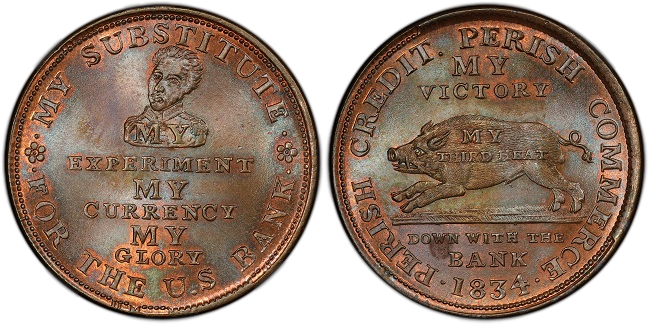
The answer has something to do with former President Andrew Jackson, The Panic of 1837, and copper shortages.
These unusual coins are called Hard Times Tokens. They were privately minted pieces. Therefore, they carried messages reflecting public sentiment, not magnanimous government phrases. These coins with their odd phrases and comedic portraits of then President Jackson were the original meme. How did they come to be?
In 1832 President Jackson vetoed a bill that would have prolonged the existence of the Second Bank of the United States. The move was bold but much of the public supported it. Many believed the bank acted unfairly by favoring northern interests over those of citizens living in the south or out west. The move, however, created an interruption in the money supply. State banks attempted to resolve this problem by increasing their bank note issuance. As a result, inflation took hold of the nation.
Jackson took action. He issued a “Specie Circular.” This was an executive order that required all payments for government land to be in gold or silver. The idea behind this move was that demanding gold and silver would solve the problem of people purchasing land with state issued paper currency which lacked “hard money” backing. This move only devalued paper money more, after all, it was no longer good for land purchases. The Specie Circular and the Deposit and Distribution Act of 1836 which moved much of the gold and silver away from commercial centers precipitated the Panic of 1837.
As a result, many small banks failed. Soon gold and silver disappeared from circulation. People still had copper cents but supplies were thinning. Private minters responded to this development by creating Hard Time Tokens. They are about the size of normal cent. Many have images depicting the political satire of the era. One version shows a turtle carrying a large treasure chest on its shell. The phrasing encircling this picture reads, “Executive Experiment.” Another, an anti-slavery version, shows a slave in shackles and reads, “Am I Not A Man & A Brother.”
Hard Times Tokens have a special place in history. They represent not only the resourcefulness of the American people during trying economic times, they also reflect the pervasive sense of injustice stemming from slavery and misguided government policies.
The tokens fall into one of three categories. The first are political satire pieces illustrating the public’s frustration with the president and the Federal Government. The second are, advertisement pieces which serve to spread the word on merchants, products, and services. The third group are those which were designed to simply resemble an ordinary US cent. Minters issued the pieces between 1832 and 1844. This long duration means that many still survive today. Collectors can own this echo from the past for an affordable price.
3 Trends That Underpin Silver in 2019
Posted on — Leave a commentRecent gains in the stock market have been a bit of a downer for the silver market.

After climbing above the $16.25 cent an ounce level in February, silver slid just below the $15.00 an ounce level. Blame it on the stock market.
For now, investors have adopted a “risk-on” attitude and have pulled back on safe-haven purchases like silver.
Despite the modest pullback in silver in March, there remain three trends that suggest silver will claw its way higher again before 2019 is over.
The Silver Institute recently released its 2019 World Silver Survey report, which has been published since 1990.
The new report identified 3 significant positive developments that emerged in the silver market last year.
While silver may be down, it’s not out for the count.
These positive developments reveal longer-term shifts that bode bullishly for silver this year and beyond. Here’s what the report said.
- Silver Demand Rose in 2018 – The First Time Since 2015
Total silver demand rose 4% to 1.03 billion ounces, according to the new Silver Institute report.
- Retail Investors Bought Silver Bars (A Lot)
The report documents a “robust recovery in retail investment, led principally by silver bar demand, which climbed sharply last year.”
- Global Silver Mine Supply Fell for Third Year In A Row
Silver mine supply dropped in 2018 continuing a recent falling trend. From 2003 to 2015 global silver supply posted steady annual increases. That trend changed three years ago.
Also, “silver scrap supply has been in retreat since 2012 and fell by nearly 2 percent last year,” the report noted.
Key finding: The rising demand and falling supply created a physical deficit of 29.2 million ounces (Moz) in 2018.
Supply and demand trends are longer-term influences on the market, which suggests the modest pullback in the first quarter of 2019 is a minor blip for silver.
Individual Investors Added to Their Portfolio
Breaking down the Silver Institute’s data, the silver coin and bar category soared by an impressive 20 percent. Digging deeper that big jump last year was entirely driven by silver bar demand, which jumped up by 53 percent.
Silver is an excellent portfolio diversifier, along with gold. Just as diversification is recommended inside the equity market, diversification within the precious metals arena offers long-term investors the ability to maximize portfolio returns while minimizing volatility. See silver bar types here, with larger investments simplified through bulk silver purchases called monster boxes.
Jewelry, Silverware Demand Also Climbed
Silver jewelry demand also climbed last hitting a total of 212.5 million ounces in 2018, the report stated.
India was the standout buyer, pushing its demand for jewelry up 16 percent to achieve a new record level.
However, American silver jewelry buyers also took the market by storm, with a 7 percent increase in 2018 to score an all-time high at 17.5 million ounces.
Around the world, total global demand for silverware rose by 6 percent last year to 61.1 million ounces.
The Bottom Line
The long-term rising demand and falling supply trends point to significantly higher silver prices in the years ahead. How high could silver climb? Using history as a guide, the silver market climbed above the $49.00 an ounce level back in 2011. Looking ahead, that means the silver market could double or triple in value based on historical pricing.
Your investment dollars buy more silver in the current market environment. If you’ve been considering adding to your precious metals portfolio, silver offers excellent value at current levels. Call a Blanchard portfolio at 1-800-880-4653 to learn about investments that may be beneficial for you.
What China, the IMF, and the Global Economy Tell Us About Gold
Posted on — Leave a commentSomething’s afoot in China. Recently, the country has been on a gold buying spree. Data indicates that The People’s Bank of China increased their gold reserves by 60.62 million ounces in March alone. This figure marks the fourth consecutive month of increased purchases. China is not alone in their fervent gold acquisitions.
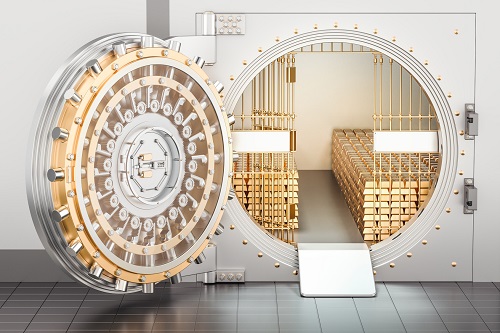
In 2018 governments across the globe added a total of 651.5 tons of bullion. This amount represents the second highest annual gain in history. Russia is an extreme example of escalating gold purchases. The country has quadrupled their gold holdings in the last decade. Their buildup of gold marks their movement away from reliance on the dollar.
China’s purchases are also motivated, at least in part, by movements in the value of the US dollar. Gold is a more desirable investment as the dollar weakens. Moreover, countries like China and Russia appear to be changing their strategy of using the dollar as a reserve currency. For example, China has been selling significant amounts of US Treasuries. Over the past year China has sold over $50 billion in US debt.
Some speculate that these moves away from the dollar and the US come as a precautionary measure as escalating trade disputes threaten economies across the globe. Others suggest that an impending economic slowdown domestically and internationally has initiated the retreat to a safe haven asset. The International Monetary Fund (IMF) offers this blunt assessment: “The global expansion has weakened.”
They continue by explaining that their recent downward revisions of expected global economic growth are due to “softer momentum in the second half of 2018.” The experts at the IMF also cite factors contributing to a slow down like new fuel emission standards for cars in Germany, financial instability in Italy, and financial contraction in Turkey. Meanwhile, China’s economy has slowed because of new regulations in the financial sector designed to impede shadow banking. Though the country has taken steps to improve the economy, many of these movements have been stimulus initiatives rather than organic growth emerging from a healthy business climate.
The US is not free from these dimming forecasts. The IMF also asserts that growth domestically will decline to 2.5 percent this year and will reach only 1.8 percent in 2020. Trade negotiations continue to be a focal point. Much of the rise and fall of economic projections for the US and countries abroad stem from concerns surrounding unresolved trade deals and negotiations.
While individual gold holders and purchasers may recoil from the cloudy global forecast, they can take solace in the fact the increased gold purchases from central banks may boost gold’s value. In fact, Goldman Sachs analysts “raised their price forecast for gold, predicting that over 12 months the metal will climb to $1,425 an ounce — a level not seen in more than five years,” according to reporting from Bloomberg.
“We expect the safe-haven bid, and to a lesser extent, gold’s inflation hedge properties, to remain key drivers of the metal’s price in 2019, complemented by a resurgence of physical demand,’’ remarked analysts with Cantor Fitzgerald, an American financial services firm.
Paying 50 Cents for a Quarter
Posted on — Leave a commentWhat do the world’s first Ferris wheel, a quarter that costs 50 cents and Chicago’s Museum of Science and Industry have in common?

Answer: The 1893 World Columbian Exposition, also known as Chicago’s World Fair.
It was the site of the world’s first Ferris wheel. Originally known as the “Chicago Wheel,” the Ferris wheel was invented for Chicago’s 1893 World Fair.
A structural engineer from Pittsburgh named George Washington Gale Ferris Jr. pitched the idea of a giant metal wheel to Daniel Burnham, the lead architect of the 1893 World Fair. Burnham and others had incredible doubts that such a structure could work or be safe. After numerous safety studies, they agreed to build it.
The world’s first Ferris wheel was enormous. It featured 36 gondolas capable of holding up to 60 people each—for a total capacity of 2,160 people.
Officially known as the 1893 World Columbian Exposition was a major event in the history of Chicago and not only because of the Ferris wheel.
1893 World Columbian Exposition Isabella Quarter
Today, collectors actively seek out the 1893 Isabella Quarter struck for this event – a beautiful and rare gem of a coin. In addition to its rarity and beauty, the story behind it and the era it represented adds an aura of intrigue and excitement to this silver coin with a tiny surviving mintage at 24,191. The original mintage was 40,000, but 15,809 were ultimately melted.
The Isabella Quarter is also a poignant reminder of an era in which American woman were undergoing dramatic change in the movement toward the right to vote. The U.S. Congress authorized the formation of a Board of Lady Managers to help plan the event. Bertha Palmer, a Chicago socialite and wife of prominent local businessman Potter Palmer, owner of the legendary Palmer House hotel worked tirelessly to help the Chicago Fair become an incredible success.
It was her leadership and suggestion that the U.S. Mint a commemorative coin with a woman on it, specifically Queen Isabella.
The 1893 World Columbian exposition Isabella Quarter was the first U.S. coin feature a real woman, as opposed to the mythical Lady Liberty. It was also the first U.S. coin to feature a foreign monarch.
Why Queen Isabella of Spain?
The 1893 World Columbian exposition was created to celebrate the 400th anniversary of Christopher Columbus’ landing in America. Potter thought it fitting to feature Isabella since she was Christopher Columbus’ benefactor and it was her directive and support that led to the discovery of America.
Sales of the Isabella Quarter weren’t so hot at the Chicago Fair. The main reason was that thrifty fair goers saw better value in the Columbian half dollar. Both the half dollar and quarter were sold for $1. Buyers preferred to go home with a 50 cent coin for their dollar instead of quarter worth 25 cents back then.
These days, the Isabella quarter sells for much more than 50 cents, with an MS69 valued at $68,500.
The Chicago World’s Fair built great notoriety for the city as a powerhouse around the globe. It showed off the immense progress and growth that occurred in the two decades after the Great Chicago Fire of 1871, which burnt down nearly the entire city.
Taking over roughly 600 acres of Chicago’s Jackson Park, it drew an estimated 27.3 million people to the city over its six-month run. Not much of the 1893 World’s Fair remains in Chicago today. A notable exception is Chicago’s Museum of Science and Industry, which was constructed as the Palace of Fine Arts for the fair.
Highly desired as a part of the commemorative series and often sought after as a “type” quarter, Isabella remains a numismatic favorite and continues to see strong collector demand.
9 Tangible Asset Investing Terms Demystified
Posted on — Leave a commentEducation is one of the keys to success. When you are new to tangible assets investing there are several terms that may not be familiar to you. Here we break down and define 9 terms to help you get started on your precious metals investing journey.
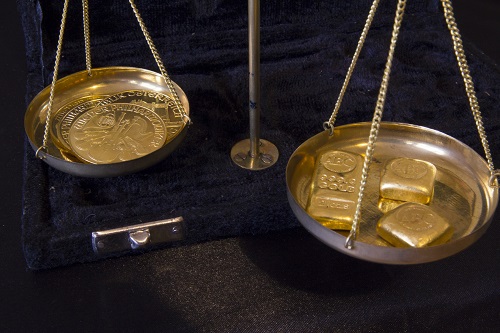
- Fiat
Fiat currency is defined as “paper money,” that is not backed by precious metals. The 5s, 10s and 20s in your wallet represent fiat money that is made legal tender by government order. Typically, there is no intrinsic value to fiat currency. The concept is important because governments can expand the money supply simply by printing more fiat currency, with nothing to back it up. In severe cases that can lead to inflation, where the purchasing power of the fiat money falls significantly.
- Gold-Silver Ratio
The gold/silver ratio represents the number of ounces of silver it takes to buy one ounce of gold. The gold/silver ratio is one way investors measure the relative value of gold and silver.
The ratio is also used as an effective timing mechanism to signal strong long-term entry points for precious metals purchases.
Where is it now?
Ratio: 85 oz. silver = 1 oz. gold
Silver currently offer better “value” than gold. Historically, readings above 65 signal that silver is severely undervalued and is a strong buy signal for the metal.
- Legal Tender
Currency that can be used in daily commerce. You may not know but the 1 ounce American Gold Eagle is legal tender. However, you probably don’t want to use it to pay for your dinner out. The coin’s legal tender value is $50 compared to the current value of the coin (prices fluctuate daily).
- Liquidity
Liquidity refers to an asset that can be easily bought and sold.
- A liquid market is deep and has many buyers and sellers.
Both physical gold and silver can easily be exchanged for cash. They are considered to be extremely liquid assets, due to the enormous large number of investors who actively buy and sell these metals around the world. Physical gold is recognized as having value in every country around the globe.
- Peak Gold
Peak gold refers to the idea that there is a limited supply of gold that we can still mine from the earth and specifically refers to the date that the maximum rate of global gold extraction is hit. From that point on, gold mining will shrink until it eventually reaches zero.
In 2015, a Goldman Sachs report suggested that there are only two decades of “mineable” gold left in the ground. The Wall Street firm also estimated that there is only about 40 years left of platinum, copper and nickel reserves.
- Premium
The price of a coin over its bullion value. Each gold bullion coin carries a small premium over the spot price of gold – usually 3-4% – to cover its manufacture and handling, but that premium is a part of the return investors receive when they sell.
- Reverse
The back side of the coin. The side usually opposite from the portrait or date.
- Self-directed IRA
Unlike a typical 401k or IRA, a self-directed IRA account allows investors to purchase and hold tangible assets in a retirement account. Yes, you can buy and hold physical gold in a self-directed IRA. There are IRS rules surrounding what types of physical metal can be put into an IRA. There are a variety of IRA approved coins that investors can buy and hold for retirement. See them here.
- Spot price
The spot price represents the live, current price of gold and silver traded on the global markets. This is determined by the over-the-counter and futures markets. You can monitor spot prices here.
What questions do you have about precious metals investing jargon? Leave a comment below or call a Blanchard portfolio manager today to ask any questions you might have? Reach us at 1-800-880-4653 or by email here.
Ultra-Rare US Trade Dollar: Coin History
Posted on — 3 CommentsIn the late 1860s and early 1870s trade between the U.S. and China was increasing. However, a threat to this trading emerged from the unlikeliest of places; the Mexican peso.
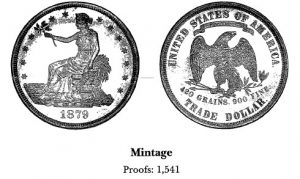 *
*
Many Chinese businesses preferred the peso to U.S. currency because the peso contained more silver than the standard U.S. dollar. This characteristic of business abroad meant that U.S. businesses had to exchange their dollars for pesos which generated costly broker fees. The government’s answer to this problem was the US trade dollar.
The U.S. started to mint trade dollar coins in 1873. The trade dollar consisted of 90% silver and weighed slightly more than the peso (420 grains vs. 416). During the first two years of production the U.S. sent nearly all the minted coins abroad to ease trade problems. Soon after, they granted the coins the status of legal tender domestically.
The trade dollar was a success abroad. Chinese businesses embraced the coin and preferred its heavier weight over the peso. Chinese merchants often put a “chop” mark on their U.S. trade dollars. These punched Chinese characters indented on the surface of the coin were likely a method for testing the authenticity of the piece. As the coin passed from one merchant to another it would occasionally receive multiple chop marks.
In time, demand for the US trade dollar surged. However, mining activity at home altered the course of history for the trade dollar.
U.S. mines in the western regions of the country were yielding enormous amounts of silver. This influx of precious metal disrupted the supply and demand dynamics in the market. Silver prices plummeted. As a result, the trade dollar fell to an intrinsic value of just 80 cents. Soon after, the U.S. saw large amounts of trade dollars flow back into the country where Americans spent the coins at their face value. In response, Congress acted and revoked the coin’s status as legal tender in July of 1876. They continued to mint the coin, but only for the purpose of exportation.
Just two years later, Treasury Secretary John Sherman ended production of trade dollar coins. However, from 1879 forward, the Treasury issued proof strikes expressly for collectors. Eventually, in early 1887, legislators passed a law allowing those holding U.S. trade dollars to redeem their coins. This act brought approximately 8 million U.S. trade dollars back into the government’s hands.
With the passing of the Coinage Act of 1965, trade dollars became legal tender once more. Today, the coins are highly sought after by collectors. The 1884 and 1885 trade dollars are considered to be the rarest of these desirable coins. Prior to 1908, these coins were not known to exist. Officials and collectors learned that ten proofs dated 1884, and five proofs dated 1885 were minted. The production of these extra pieces was not recorded in official records. In 2006, a collector purchased an 1885 U.S. trade dollar in a private transaction for $3.3 million.
Collectors often use extra scrutiny when collecting trade dollar coins as their rarity, value, and history make them a prime target for counterfeiters.
*Image courtesy of PCGS
Rainfall and Other Unseen Forces Influencing Gold
Posted on — Leave a commentThe vast ocean of data available to people today reveals an indisputable truth: things are not what they seem. Dive below the surface of the waters and you’ll learn that many unseen forces are pushing and pulling on our market.

Sometime these forces are nefarious. Examples include the misrepresentation of risk during the global financial crises and the inflated balance sheets during the dot com bust. However, some of these unseen forces are simply acts of nature. Consider rainfall and gold.
As we’ve discussed in previous articles at Blanchard, India consumes 849 metric tons of gold per year representing the second largest demand in the world. Only China consumes more and by a small margin. Moreover, the middle class in India is projected to increase to 547 million within the next six years. This has meaning for gold because many expect those joining the middle class to add to these gold consumption figures.
So, where does rainfall factor into this picture? The rural population within India accounts for an estimated 60-70 percent of gold consumption within the country. Rainfall is critical to their way of life. With the right amount of rain those living in rural regions can ensure crop yields and, as a result, their income and their income will influence their ability to buy gold.
In fact, the weather during India’s monsoon season has strong implications for the country’s entire economy. Even when the level of rainfall drops below 90 percent of the seasonal average, the government in India considers the situation to be a drought. When India suffers a dry period the rest of the world notices because the country is the second-largest producer of rice, wheat, sugar and cotton in the world. Consider that in 2009, unfavorable weather forced India to import sugar. As a result, global prices spiked, and inflation followed. The monsoon season even has implications for the country’s power grid. With more rainfall comes better irrigation and more substantial hydropower output.
India’s rainfall is a reminder that many of the factors underpinning movements in the price of gold are things we rarely consider. For example, the strength of India’s currency, the Rupee, also has a major influence on gold prices. Much of the gold demand within the country is satisfied with imports. When the value of the Rupee, relative to other global currencies, falls imports generally decrease and gold follows.
Additionally, the festival and wedding season in the country influence gold purchases given that many people in the country buy gold for these occasions. Gold has a major place in the country’s cultural legacy. Gold is a common wedding gift and carries far more religious import in India than any other country.
As the world becomes a global marketplace and economies exact increasing influence on one another, previously ignored factors like rainfall in India will become important to savvy and strategic gold investors.
Why You Should Add Silver to Your Portfolio Now
Posted on — Leave a commentLong considered the ‘poor cousin’ to gold, silver is forecast to shine in 2019 with a rally of more than 10% forecast by Capital Economics.
“We expect silver prices to rally by more than 10% this year as safe-haven demand returns and mine production falters,” Capital Economics wrote in a March 19 research note to clients.
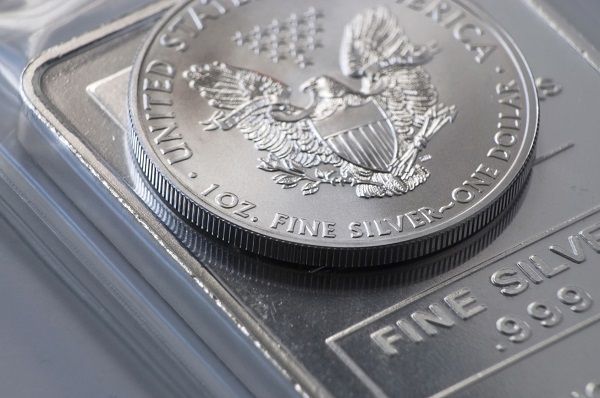
Silver climbed in recent months after marking out a solid bottom on the daily chart around the $14.20 an ounce area. Silver recently traded around $15.40 an ounce.
Capital Economics projects silver gains toward $17.50 an ounce by year-end.
2 Key Drivers for Silver Gains
Falling silver mine output in 2019, combined with fresh safe-haven investment demand means “silver will regain its status as one of the top commodity price performers in 2019,” Capital Economics said. Let’s break that down further.
Safe haven demand
Sluggish economic growth both in the U.S. and around the globe will pressure stock markets lower, Capital Economics projects. In turn, this will stimulate investor “risk aversion” and spark asset reallocation into safe-havens including gold and silver, the firm predicts.
Supply is stuttering
Silver production at the world’s largest mines has declined in recent years. A dozen of the largest silver mines registered declining output of about 9% in 2018. Notably, “the Escobal mine remains closed and we don’t expect it to restart until 2020 at the earliest,” Capital Economics said.
Investment demand is already picking up
Investors clamoring for safe-haven tangible assets already boosted U.S. silver coin demand in early 2019. The U.S. Mint briefly ran out of silver coin inventory in February due to the heightened demand.
Investing Options
Adding physical silver to your portfolio is easy.
You can buy a 2019 1 ounce American Silver Eagle coin for as little as $18.19 an ounce (market prices constantly fluctuate).
All silver and gold bullion coins carry a small premium over the spot price of silver or gold– usually 3-4%. That cover the coin’s manufacture and handling, but that premium is a part of the return you receive when you sell.
Allocating larger investments to silver bullion is simplified through a monster box purchase. Learn more about that here.
The Bottom Line
Silver has under-performed gold dramatically in recent months. But, major investment firms turned bullish on silver. A large price rally is predicted this year in silver. If you haven’t fully diversified your portfolio, consider adding silver assets now.
When the Road Curves for Investors
Posted on — Leave a commentThere will always be a few bends in the road to long-term wealth creation. Perhaps curves is a better word than bends.

Recently, the yield curve inverted. This has spooked investors. The last time this happened we were in the opening scenes of the global financial crisis.
Why does an inverted yield curve matter? Analysts have long noted that most, though not all, recessions are preceded by an inverted curve. Therefore, many consider an inverted curve to be harbinger of doom. In fact, an inverted yield curve has preceded the last seven recessions.
Viewing an inverted yield curve with some trepidation makes sense. The reason: when the curve is inverted it signals that investors, on the whole, are less optimistic about the short-run than they are about the long-run. Therefore, they demand more of a return on shorter-term investments than those that are long-term. This is why people took notice this week when the spread between 3-month and 10-year U.S. Treasury’s fell into negative territory.
Part of this development is due to the Federal Reserve’s recent decision to withhold from raising interest rates again this year. “The U.S. Federal Reserve suggested U.S. economic growth was slowing, which has spilled over into notions that the rest of the world economy might be experiencing slower growth,” remarked a senior analyst with Kitco Metals.
Concerns about slowing global growth are more than emotional, they’re empirical. Consider that factory output in the Eurozone has fallen this month at a faster pace than it has in six years. Stocks have been in decline in the U.S., France, Germany, and the U.K.
Despite some favorable conditions in the U.S., namely low unemployment, an improving housing market and respectable corporate earnings, many are concerned that economic troubles abroad will destabilize other economies. It’s not surprising that gold recently edged higher and is up 0.8 percent this week. “I still believe that with the geopolitical and the Brexit situation, we may be heading higher,” remarked Afshin Nabavi, a senior vice president at Swiss financial services company MKS SA.
Concerns about troubles in Europe spilling over into the U.S. are not unfounded given the increasing correlation between the performance of U.S. stock with European stocks. Investors are learning that diversification means something different today. It’s not enough to hold a range of stocks across sectors. True diversification now means owning various asset classes including precious metals.
In fact, some investors are broadening their focus beyond gold, they’re capitalizing on opportunities within silver because the ratio of the price of one ounce of gold to one ounce of silver is at 85 now. This number is significant because rarely does this ratio exceed 80. The bottom line: silver is relatively inexpensive.
Some are taking this low cost and a cooling equities picture as an indication that now is the perfect time to diversify. Including precious metals in a portfolio gives investors the backing of a universally accepted commodity that carries intrinsic value.
4 Investing Ideas for Spring
Posted on — 1 CommentDaylight is getting longer every day now.

Each March, the Spring Equinox marks the day in which daylight equals to night. The word equinox stems from the Latin words for “equal night”—aequus (equal) and nox (night).
Spring is a time of renewal and rebirth. The earth awakens from its frozen wintry tundra and trees, flowers and gardens begin to bloom.
Spring is the perfect time for investors to plant seeds for growth in their portfolio too.
We assess 4 key market trends and offer insights.
- The Gold Trend Points Higher
Since August, gold has climbed 14%. Goldman Sachs recently upped its 12-month forecast for gold to $1,450. Gold is in an uptrend and there is more reward on the upside.
Investing in gold bullion offers investors a safe haven, a portfolio diversifier, an inflation hedge and a vehicle to grow your wealth. The trend is your friend.
Consider adding gold bullion to your portfolio now in order to take advantage of the rising price trend.
- Rare Coin Index Eased in March
The Rare Coin Values Index, which tracks the percent change in retail prices for 87 rare U.S. coins since January 2000, hit a new all-time high in January and then again in February. The index eased slightly in March, which marked only the third decline in the last 12 months.
The macro trend for rare coins remains solidly bullish. Investors of all kinds have been turning to rare coins for capital appreciation, diversification, non-correlation to stocks and as a hedge against inflation.
Consider adding a new coin to your portfolio now as the March pullback offers a great time to buy in the uptrend. Choose the rarest coin that you can afford. That could be a $2,000 coin or a $20,000 coin. It is the rarity factor that will maintain its strong long-term demand and price appreciation.
- Silver Is Cheap
The gold/silver ratio reflects the number of silver ounces it takes to buy an ounce of gold. The gold/silver ratio offers valuable insights to determine if one metal is over or undervalued versus the other. Historically, there have been only a few occasions that the gold-silver ratio traded above 80.
The gold/silver ratio stands at 85 right now. That signals that silver is dramatically undervalued and is a strong buy signal for the metal.
Consider the purchase of a monster box of American Silver Eagle coins.
- Invest your Tax Refund in Tangible Assets
If you find yourself with some extra funds from the IRS this spring, consider adding to your tangible assets portfolio.
You can diversify your tangible assets portfolio with the purchase of a new kind of bullion or coin. Well diversified portfolios include a mix of gold, silver bullion and rare coins.








